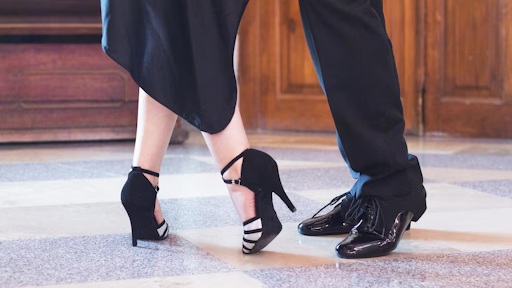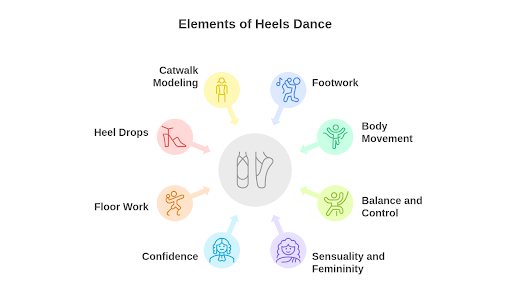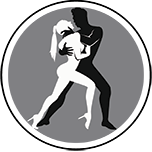How To Dance In Heels: A Guide For Salsa And Bachata Beginners
Posted on - 04 July 2025

Are you getting ready for a school dance performance, planning to shine at a club, or learning salsa for your wedding’s first dance? Dancing in heels might feel scary or overwhelming, especially as a beginner. You might be worried about tripping on the dance floor. You probably have questions like:
How do I dance in heels without falling?
What are the best heels for dancing?
Does dancing in heels hurt?
The good news is that doing bachata or salsa dance is totally doable in heels!
With the right shoes, some practice, and a positive attitude, you will start moving confidently in no time. But as a beginner, you have many more questions; we know it!
Therefore, we present this guide to learn salsa or bachata dance in heels to help you start your heels dance journey.
How To Dance In Heels? Key Takeaways:
Overcome fear:Practice and self-compassion are key to building confidence.
Choose the right heels:Wear comfortable heels with ankle straps and a stable base.
Strengthen your body:Focus on core, foot, and leg exercises to improve balance and control.
Maintain good posture:Keep your core tight and step on the ball of your foot for better stability.
Start with basics:Practice simple moves like bevels and swivels to gain confidence and fluidity.
Take classes:Join professional dance classes for structured learning and expert guidance.
Practice regularly:Consistent practice is essential for mastering dancing in heels.
How To Prepare Yourself For Dancing In Heels?
Your journey to dance in heels starts in your mind, not on the dance floor. Here is what you need to do to feel confident about dancing in heels:

Acknowledge Your Fears
It’s okay to feel nervous! You might think, “What if I fall? Will people laugh? Will dancing in heels hurt?” Be kind to yourself and remember you’re a beginner. Everyone starts somewhere.
Note: The more you practice, the less scared you’ll feel.
Don’t Compare Yourself To Experienced Dancers
Comparing yourself to others can make you feel down. Don’t worry about how good other dancers look—they’ve practiced a lot! Stay positive and focus on your own progress.
Note: If others can do it, you can too, but with practice.
Understand The Science Behind Salsa In Heels
You might think heels are just for looks, but they do more than make you look graceful. Heels shift your weight to the ball of your foot (the area between your toes and arch), which is a must in salsa and bachata. This helps you:
Engage your core muscles for better balance.
Stand taller with a straighter posture.
Move with smoother, longer lines.
Note: Heels aren’t just pretty—they help you dance better!
Know That Mistakes Are Part Of Learning
Don’t get upset if you miss a step. Enjoy the process! Get excited about your class, meeting new people, and trying something new. Give yourself time to learn, and keep practicing.
Don’t Push Too Hard
Trying to learn too fast or comparing yourself to others can make dancing stressful. Instead, focus on what you learned today and how you improved. Small steps lead to big progress.
Dancing in Heels Roadmap:
Learn a step → Practice → Get better → Try the next step → Repeat → Master a routine.
How Do You Choose The Right Heels For Salsa Dance?
The most important part of dancing in heels is picking the right shoes. You might be wondering:
Can I dance in regular heels?
Should I buy platform heels?
Do dance heels need open toes?
Regular heels from the streets or platform heels are not right for dancing! Choosing the wrong heels can cause blisters, back pain, or a sprained foot. Here’s how to pick the perfect pair:
The Fit
Your heels should feel snug but not tight. Look for shoes with:
An ankle strap to keep them secure.
Open-toe heels with enough space so your feet aren’t squished.
The Heel Type
Stiletto Heels, or kitten heels, are comfortable and best for dancing.
Note:Avoid platforms or chunky heels as they are harder to balance.
Heel Length
Beginners:Start with 2–3 inch heels for better balance.
Intermediate:Try 3–4 inch heels once you’re comfortable.
Experts:Go for taller heels if you’re confident.
Material
Choose leather or suede soles. They’re not too slippery or too sticky, so your dance moves flow smoothly. Avoid regular party heels—they’re not made for dancing and can hurt your feet.
How To Prepare Your Body To Learn Dance In Heels?
Once you have the right heels, it’s time to get your body ready. Here are three key things to work on:
Core
Foot muscles
Posture
How To Build Core And Hamstring Strength For Heels Dance?
Strong core and leg muscles keep you steady on your heels. Try these simple exercises:
Planks:Hold a push-up position with straight back (30–60 seconds)
Hamstring Curls:Use a resistance band, bend your knees ( 3 sets of 12)
Core Holds:Sit in a V-shape, hold for 10 seconds. (Repeat 5 times)
👉 Core exercises help you control your moves, stay balanced, and prevent falling.
How Can You Strengthen Your Foot Muscles For Heels Dance?
Strong feet make your steps smoother. Try these exercises to make your footwork more precise:
Towel Scrunches:Scrunch a towel with your toes for 2 minutes.
Balance Drills:Stand on one foot for 30 seconds, switch sides, repeat 3 times.
Ankle Rotations:Circle your ankles, 15 seconds each way
What Is The Right Posture For Heels Dance?
Good posture keeps you from falling and makes you look elegant. Here’s how:
Core:Tighten your stomach muscles.
Shoulders and Arms:Keep shoulders back and arms relaxed.
Legs:Straight with ankles and thighs touching together
Hips and Knees:Hips steady, knees slightly soft (not locked).
Foot Placement:Step on the ball of your foot first, then lower your heel.
Weight Shifts:Shift your weight smoothly between feet.
Note: Practice standing in heels for 5 minutes a day to make this feel natural.
How Do You Start Salsa Or Bachata Dancing In Heels?
Now that you’re ready, it’s time to break a leg in those heels (not literally, though😅!) Let’s start with a simple warm-up and walking routine.
10 Minute Beginner Heels Dance Routine: Step-By-Step
Starting a 10-minute routine is easy and helps focus on balance and core strength. Play upbeat pop or R&B music (like Dua Lipa or The Weeknd) for a fun vibe.
Prerequisite: Warm-Up
Perform core activation and ankle strengthening exercises mentioned in the previous section.
Part 1: Bevels (2 Minute):
Bevels teach balance and hip movement for dancing.
Stand with feet hip-width apart, core tight.
Shift weight to left foot (ball first, then heel), bend right knee, tilt hips left. Hold 4 counts.
Switch to right foot, bend left knee, tilt hips right. Hold 4 counts.
Repeat 5 times per side.
Part 2: Dance Walking in Heels (5 Minutes)
Basic Walk: Take 8 steps forward, swing your hips side to side, and relax your arms. Do twice.
Controlled Walk with Pause: Walk 4 steps, stop in a bevel pose for 2 counts, continue. Repeat 4 times.
Part 3: Hair Whips (1 minute )
Controlled Head Movements
Start by standing tall and engaging your core.
Gently tilt your head back, then sweep your head from side to side, mimicking a hair whip.
Make smooth neck movements to add style to your dance.
Part 4: Hip Swivels (1 minute)
Fluid Hip Rotations
Stand with feet hip-width apart and your knees slightly bent.
Slowly rotate your hips in a circular motion—first clockwise, then counterclockwise.
Focus on keeping the movement smooth, with your upper body staying still.
Cool-Down (1 Minute)
Shake Out (30 seconds):Wiggle legs and arms to relax.
Core Stretch (30 seconds):Twist your body side to side, 15 seconds each way.
At Home Vs. Salsa Or Bachata Dance Classes
| Aspect | At Home | Salsa/Bachata Heels Dance Class |
| Guidance | Self-taught, using online videos or tutorials | Expert instructors provide step-by-step tips and tricks |
| Shoe Selection | Trial and error, you may choose the wrong heels | Help picking comfy, stable dance heels to avoid pain |
| Exercises | General workouts may miss dance-specific moves | Targeted core, leg, and foot exercises for balance |
| Event Prep | Limited structure, no tailored plan | Lessons customized for weddings, clubs, or events |
| Learning Environment | Solo can feel isolating | Fun group setting, share tips, build confidence |
| Progression | Unstructured, may skip the basics | Slow start with walking/bevels, perfect for beginners |
Must know: Classes with the right guidance and consistent practice help you dance naturally and pain-free in heels.
Takeaway:
Dancing salsa or bachata in heels is about confidence, comfy shoes, and practice. Get the right dance heels and practice daily to move smoothly. If you’re in Orange County or nearby, join RF Dance to learn salsa, bachata, or cumbia dance from experts and boost your skills.
Start your dance journey today!
Frequently Asked Questions (FAQs) About Dancing in Heels:
1. How to Dance in Heels for Beginners?
Start with comfortable, lower heels (2–3 inches), focus on posture, core strength, and practice basic steps like bevels.
2. How Do Dancers Not Slip in Heels?
Dancers wear shoes with leather or suede soles for the right grip, avoiding slipping while maintaining smooth movement.
3. What to Expect in a Heels Dance Class?
You’ll learn posture, balance, and basic moves like bevels and hip swivels, all in a structured, supportive environment.
4. Does Dancing in Heels Hurt?
It can be uncomfortable at first, but proper shoes and technique can minimize pain over time.
5. Can I Dance in Regular Heels?
Regular heels aren’t designed for dancing. Dance-specific heels offer better support and stability for movement.
 RF Dance
RF Dance